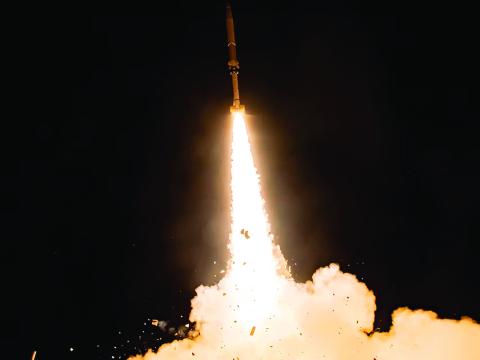Infant Voice Over Internet Protocol Takes Grown-up Steps Into Space
High-speed, space-based system to link international populace with vessels and other planets.
Researchers are adapting voice over Internet protocol technology to establish communication between Earth and spacecraft, satellites, and, perhaps someday, other planets. Using modified commercial approaches, scientists will design space-based and mobile Internet standards that provide access to science mission data and interactive communication with inhabited and uninhabited spacecraft. These technologies also will become the connection to a future Mars-based communications infrastructure.
New technology, more demanding mission objectives and decreasing budgets are driving dramatic changes across many segments of the space community. These changes mandate a reorganization of the way space communication is executed and require more active public-private partnerships to help achieve research and mission goals. A space-based Internet is one step toward the success of advanced missions.
Voice over Internet protocol (VoIP) creates an opportunity to merge the Internet and space communications communities. The National Aeronautics and Space Administration (NASA) and Cisco Systems, headquartered in San Jose, California, have teamed to research and implement new data communications technology using the convergence of voice, video and data through a satellite connection.
According to experts working with space communications protocol standards, space missions have always required the reliable, secure transfer of messages between space and ground. In the past, these requirements have been met by combining custom-designed software with control by human operators. A space mission operations environment comprises both ground and space information infrastructures, which then presents a much different environment. In space, relatively few end systems and networks exist, and their performance is far below that of ground nodes.
Experimental technologies that characterize the NASA/Cisco project include modifying existing commercial standard protocols, including asynchronous transfer mode and transmission control protocol/Internet protocol over broadband satellite links. As a result, NASA will develop and enhance the use of the Internet over space-based telecommunications networks in the national and global information infrastructure. The government agency aims to fully exploit emerging global broadband satellites and especially hybrid networks.
William D. Ivancic, senior research engineer, Glenn Research Center, NASA, Cleveland, Ohio, relates that a long-term goal of the interplanetary Internet is to create a ubiquitous, space-friendly Internet protocol for use in shuttlecraft, space stations, earth observation satellites, and eventually on other planets. The technology will speed up the acquisition of research data while reducing costs, which will allow for the customization of communications packages for different craft. The interplanetary Internet also will support increased robotic exploration and establish a framework for enhanced human presence in space.
To accomplish these short- and long-term goals, the NASA/Cisco team is using advanced software engineering and an established Internet testbed to address several topics, Ivancic shares. Researchers are examining protocol header compression, moving satellites, error-prone and congested networks, and terrestrial-based methods of roaming focused in a space-based environment.
Much of this work is being done in a space communications concept laboratory known as the in-space Internet node testbed. The facility simulates a terrestrial network using the Internet to connect to space-based IP nodes for data, voice and video communications. One application involves transmitting VoIP with the ground-side voice module attached to the NASA Glenn Center's private branch exchange. NASA then runs VoIP to the space side of the network using the same satellite used for data, and voice and data are transmitted simultaneously. An advanced communication technology satellite (ACTS) T1 link is currently used in this laboratory environment. The terrestrial side of the network uses a 100 baseT for communications. A 900-megahertz cordless telephone and a laptop that uses a 100 baseT network are attached to a router. This equipment will be placed in a spacecraft, allowing the infant VoIP technology to take a new step. Although VoIP testing currently is not fully implemented in space, the ACTS technology used in testing is live, with the data network operating through space.
According to Daniel Shell, consulting system engineer, Federal Advanced Technologies, Wireless and Satellite, Cisco Systems, Cleveland, Ohio, many challenges remain. For example, when a person speaks over satellite links, a delay occurs because the message cannot travel faster than the speed of light. The greater the distance, the longer the delay (see page 69). The VoIP designer also must consider buffer sizes, packet sizes and the packet loss rate. Large packet sizes and buffers increase the delay.
Bandwidth constraint is another challenge. "You are not going to get an infinite amount of bandwidth because the bandwidth is the size of the pipe," Shell notes. "You hear about Ethernet, which runs at a 10-megabit-per-second pipe--that's standard Ethernet. When you're talking to a shuttle, you might get something less for your shuttle to ground communication such as the kilobits per second range. It's OK, but not like megabits. Your bandwidth is smaller when you're talking to devices farther out. Let's say we're talking to Mars. It takes a strong signal to reach the planet. That's a bandwidth constraint based on power," he explains.
Noise on space links, despite existing correction codes, also must be overcome. In an Internet hookup, external noise is picked up from equipment in the vicinity, including electrical transformers, the atmosphere and items in space. In an Internet environment, noise slows down the data transfer rate because the system must adjust its speed to match conditions on the line.
Noise is a more significant problem in wireless technologies. In general, noise originating from outside the system is inversely proportional to the frequency and directly proportional to the wavelength. At a low frequency such as 300 kilohertz, atmospheric noise is much more severe than at a high frequency such as 300 megahertz.
Engineers are striving to develop better ways to address the noise issues. The traditional method has been to minimize the signal bandwidth. The less spectrum space a signal occupies, the less noise passes through the receiving circuitry. However, this approach limits the maximum speed at which messages can be delivered.
Security is another concern, Shell says. If an experiment on a space vessel is being run remotely from Earth, the goal is to prevent tampering. Link encryption, end-to-end encryption, implicit access controls based on key management, and embedded security labels are some of the approaches under consideration.
Ivancic notes the relevance of the protocol research to the scientist as well as to the other users. "The proposed research crosses space science, earth science, and human exploration and development of space enterprises. This will allow a more robust and autonomous communication structure for colonies of intelligent robots, rovers, balloon and aircraft systems, sensor webs, access to knowledge, interspacecraft communications, and Internet connections to the international space station and space shuttles," he shares.
Experts also predict the protocol will increase educational possibilities. It will provide an opportunity to interact with scientists and researchers in space, and researchers even envision instructors teaching directly from space shuttles or from an orbiting space platform using VoIP technology. "This is the wonderful extreme of distance learning," remarks Jim Massa, director of global government alliances, Cisco Systems, Herndon, Virginia.
Remote experiments could also be conducted. Data would be collected and used to monitor long-term environmental changes on Earth. For example, a farmer could examine pollution effects, weather predictions and vegetation to predict future market conditions. To accomplish this, users would need to communicate with a spacecraft to establish and monitor experiments.
Massa notes that the project is the result of a successful government and industry team. The public-private partnership is often talked about, but results are not always obvious, he explains. Many times industry and government will work together in an environment like that of a task force, and the completed work is difficult to measure.
"When you are able to have communication over a single network, and that includes data and voice, it's very tangible. You are able to reduce the cost of a mission and every mission that follows by several percentage points because you can eliminate a whole communications system [by using existing commercial technology] that had to be [designed] from the ground up. That can only be done when government and industry work together. Neither one of us could do that without the other," he concludes.




Comments